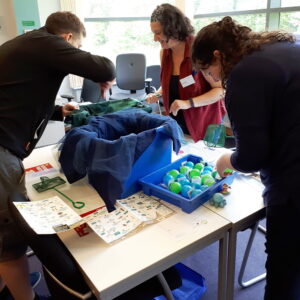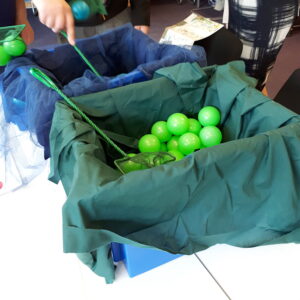Identify – Invertebrates
This activity was created as part of a Gratnells What’s In My Tray CPD workshop for secondary science teachers and technicians to support practical work and delivery of the curriculum. It can be carried out as a stand-alone activity for students or combined with other activities from the session to form a STEM carousel.


You will need (per team of 4):
- 2 x Extra deep Gratnells trays with lids (one green and one blue)
- 1 x Shallow Gratnells (F1) tray with lid
- 2 x FSC freshwater name trail (or alternative pond invertebrate ID guide of your choice)
- 2 x FSC bugs on bushes fold out chart (or alternative hedgerow invertebrate ID guide of your choice)
- 4 x Small fish tank nets
- Green ball pool balls sufficient to fill one extra deep Gratnells tray
- Blue ball pool balls sufficient to fill one extra deep Gratnells tray
- Blue and green fabric and netting to line each extra deep tray (~1m2 of each)
- Laminated picture cards of individual bugs on bushes
- Laminated picture cards of individual freshwater invertebrates
- Sticky and fluffy self-adhesive strips of Velcro (~10cm each)
- Paper and pen/pencil
Tip: Select an ID guide that is appropriate to the age and ability of the participants.
This activity also works for individuals or smaller teams, just increase the amount of time allocated to complete it.
Once prepared, this activity can be repeated multiple times, reusing the same equipment for each team.
Preparation:
- To make the laminated picture cards, photocopy one of each ID guide on to paper and cut out individual pictures of 10 pond invertebrates and 10 bugs on bushes of your choice, removing their names as you cut them out. Chose a diverse selection from across the ID chart. Be sure to keep a list of the invertebrates you select as that will form the answers to the challenge. Laminate each picture and cut out individually. Place a small piece of fluffy Velcro on the back of each laminated invertebrate picture. Keep the freshwater invertebrates and the bugs on bushes separate.
- Place a small piece of hooked Velcro on to each of 10 green and 10 blue ball pool balls.
- Velcro together the freshwater invertebrates and the blue ball pool balls and the bugs on bushes and the green ball pool balls. The blue balls represent water and the green represent leaves.
- Line the outside edges of the green extra deep Gratnells tray with the green fabric and netting. Fill the tray with green ball pool balls, including the ones with the invertebrates attached, and put the lid on. This represents a hedge or bush full of invertebrates.
- Repeat for the blue extra deep Gratnells tray using the blue fabric and netting and the blue ball pool ball. This represents a pond full of invertebrates.
- Place the ID guides and fishing nets into the shallow Gratnells tray and put the lid on.
What to do:
- Approach the trays and lift the lid
- Remove the nets and the ID guides from the shallow tray.
- Do not touch the balls with your hands. Use the nets to ‘capture’ the invertebrates which can be found ‘hiding’ in the extra deep trays and transfer them carefully into the shallow tray. Take care to keep the pond (blue tray) and hedge (green tray) invertebrates separate.
- Use the ID guides, following the yes/no key, to identify the pond and hedge invertebrates. There are 10 of each.
- Write the full name of each invertebrate you have identified down in ALPHABETICAL order on the answer sheet provided.
- Half a point per correctly identified invertebrate. 10 points available in total.
- Points will be deducted for any balls escaping the trays so search carefully!
Example answer sheet
| Pond Invertebrates | Hedge Invertebrates |
| 1 | 1 |
| 2 | 2 |
| 3 | 3 |
| 4 | 4 |
| 5 | 5 |
| 6 | 6 |
| 7 | 7 |
| 8 | 8 |
| 9 | 9 |
| 10 | 10 |
Tidy up time:
- Re-attach the invertebrates to the correct coloured balls, pop them back into their original trays (hedge or pond), mixing them up with the blank balls and replace the lids.
- Put the nets and ID guides back into the shallow tray and replace the lid.
When all participants/teams have completed the activity, swap answer sheets with the next team and mark the answers.
The activity leader will put the list of correct answers up on the screen/board and call them out. It does not matter if your answers are not in the correct alphabetical order, but it does help to mark them quickly if they are.
What is happening?
The participants are taking part in a simplified simulated field ecology activity, ‘capturing’ invertebrates and developing identification skills using age appropriate ID guides or keys. These skills can then be put to good use when carrying out a real pond dipping activity <hyperlink to the Pond Dipping SmartCase Dr Forsey lesson plan> or bugs on bushes activity <hyperlink to the bugs on bushes SmartCase Dr Forsey lesson plan> in the local environment.
Other things to try:
- Make more than 10 laminated cards for each type of invertebrate to extend the challenge and further develop identification skills.
- Follow the links above and carry out a real pond dipping and bugs on bushes activity in your local environment, testing out your invertebrate identification skills on some live specimens.
Health & Safety
As with all Gratnells Learning Rooms What’s In My Tray activities, you should carry out your own risk assessment prior to undertaking any of the activities or demonstrations.

